
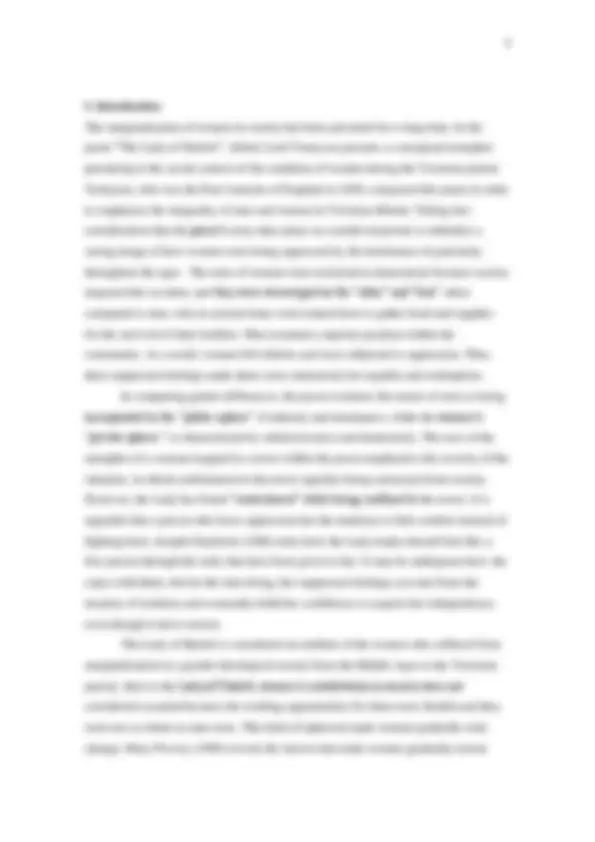

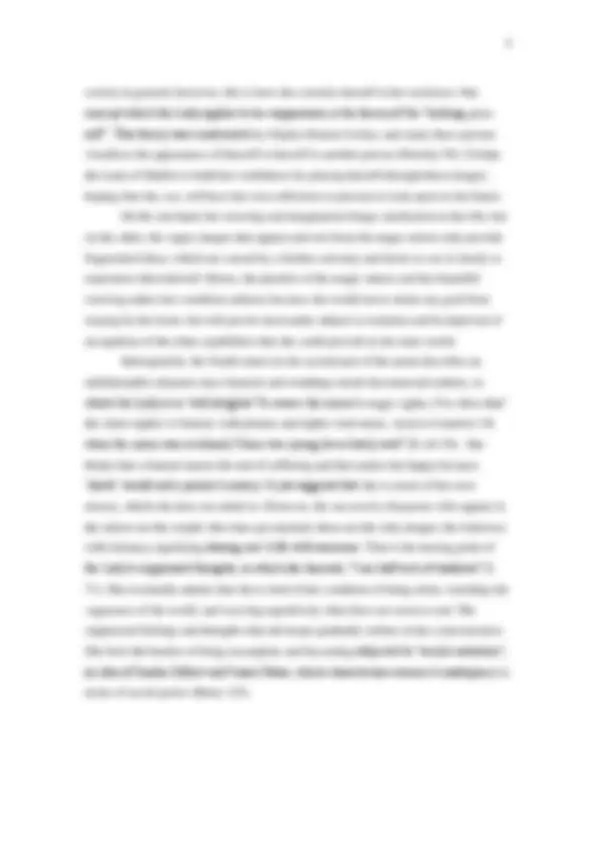
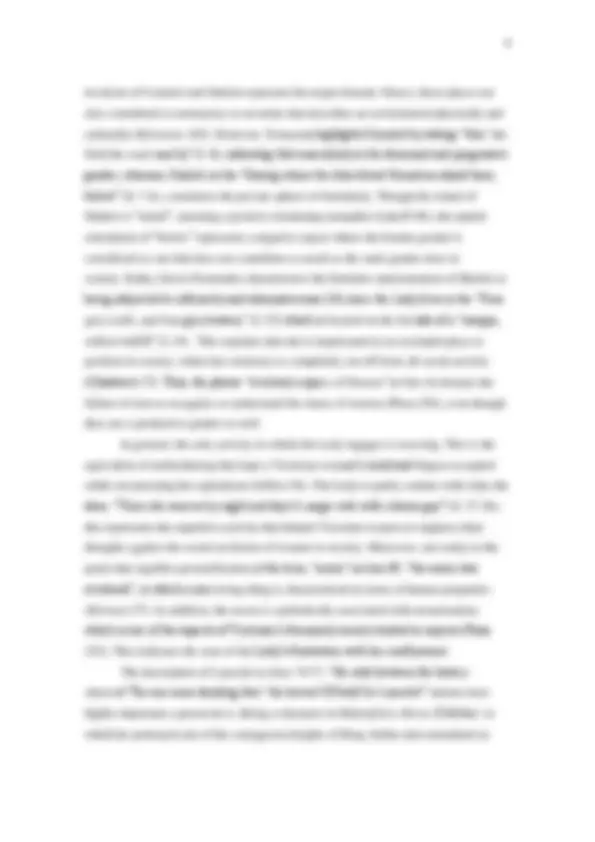
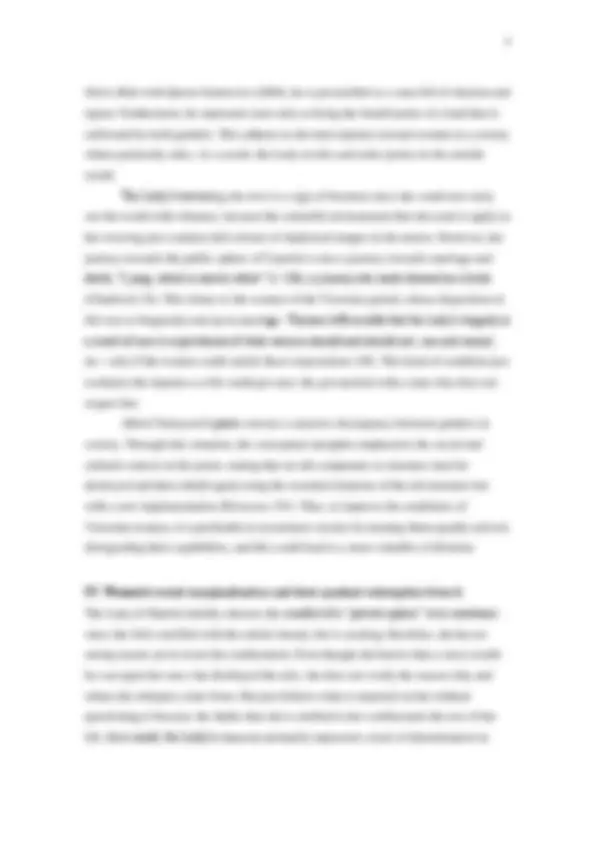
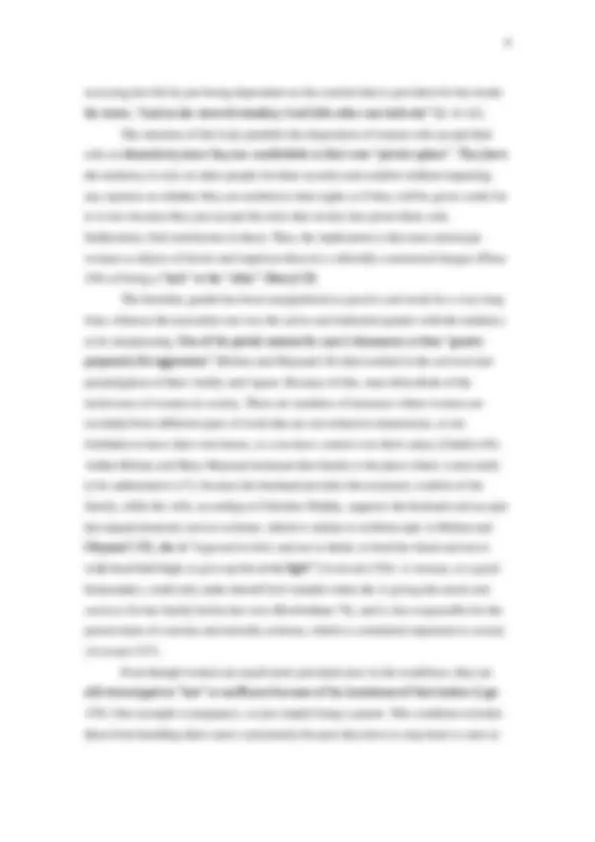
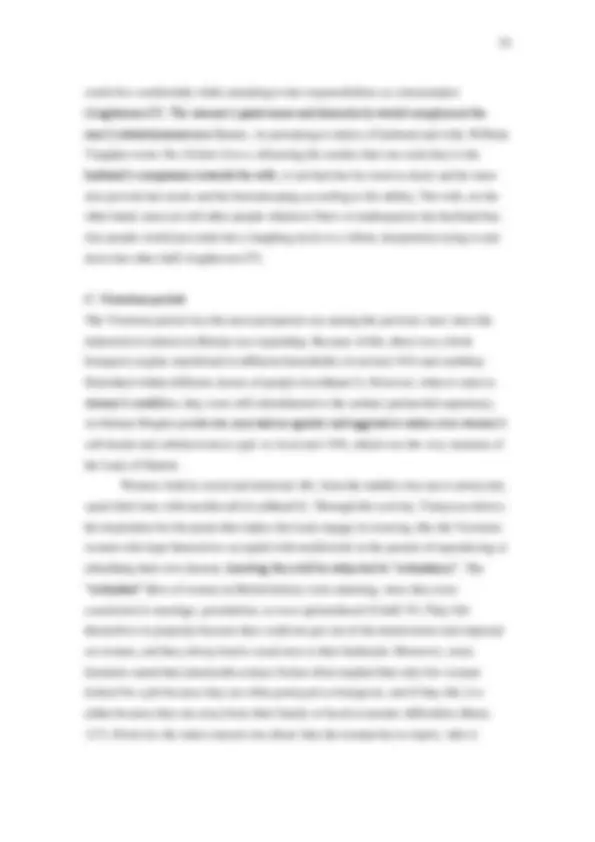
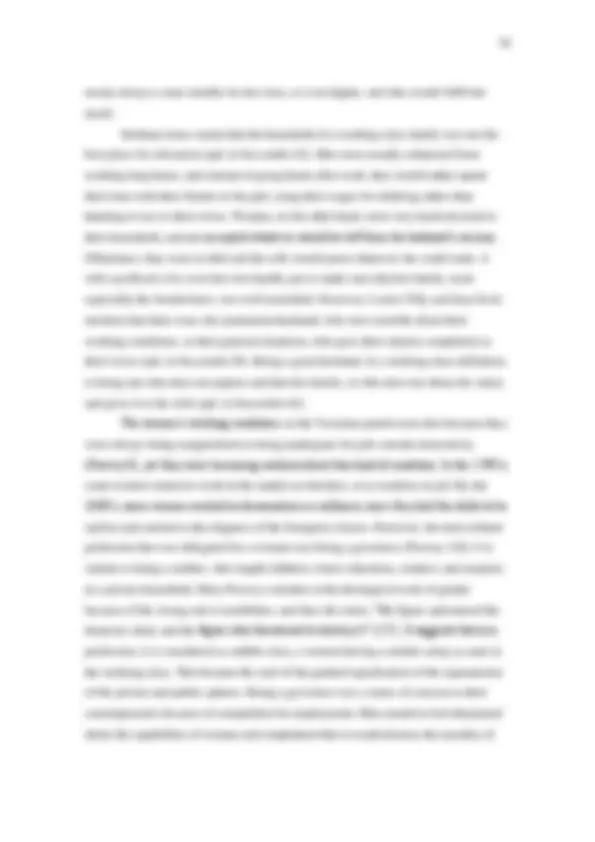
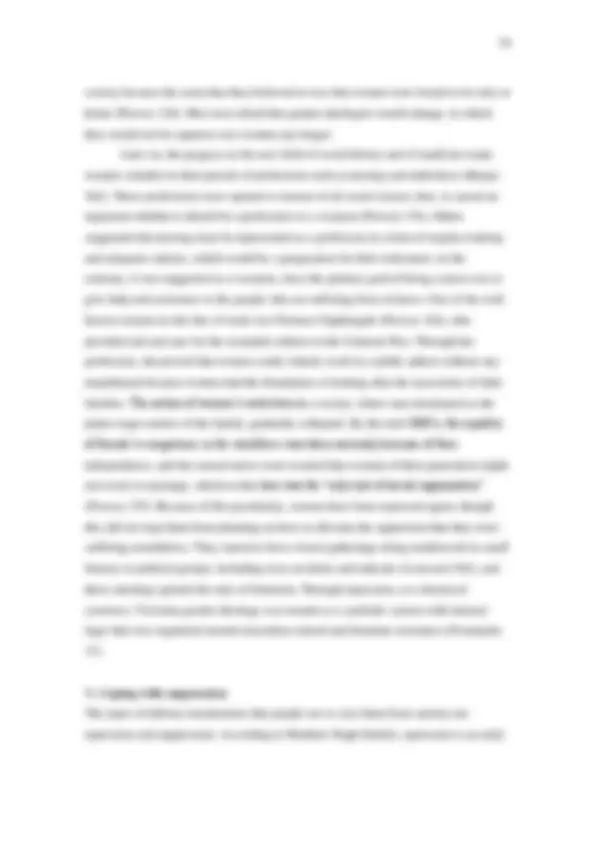
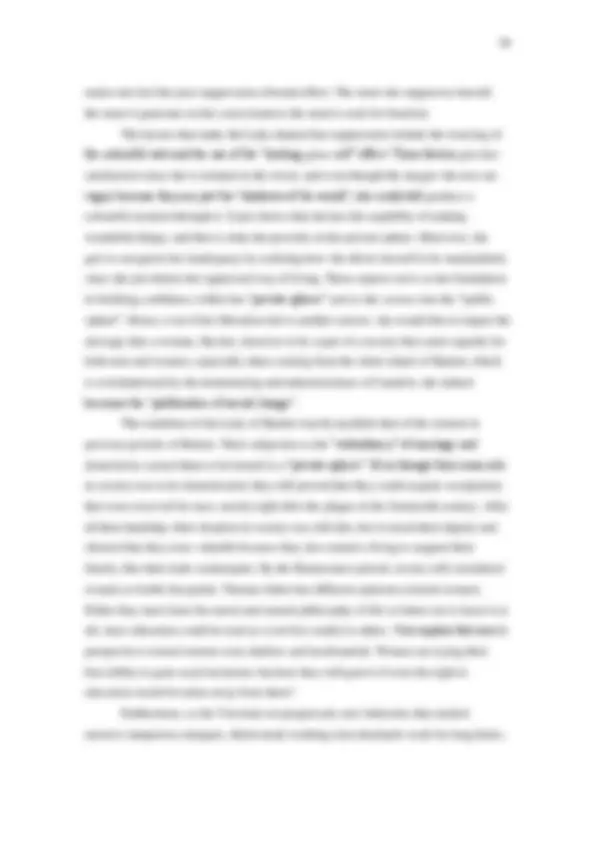
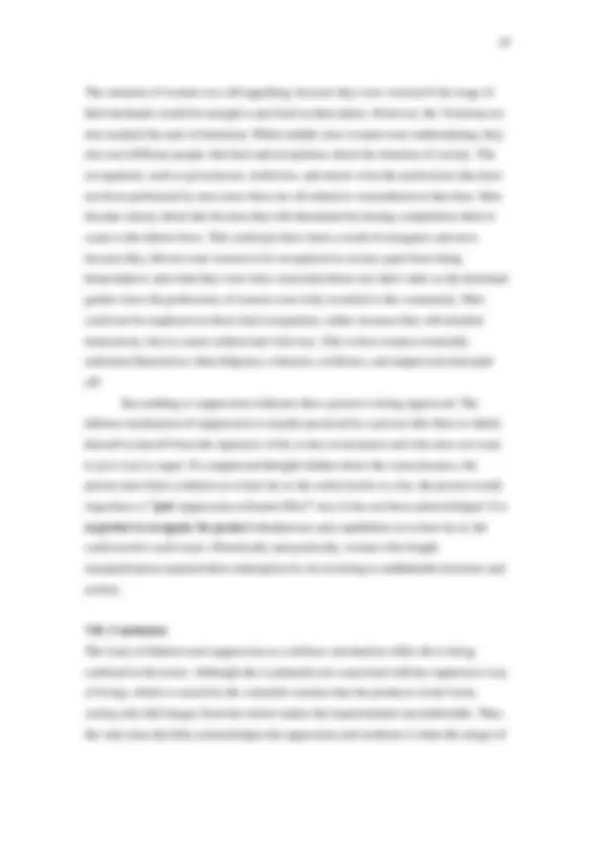
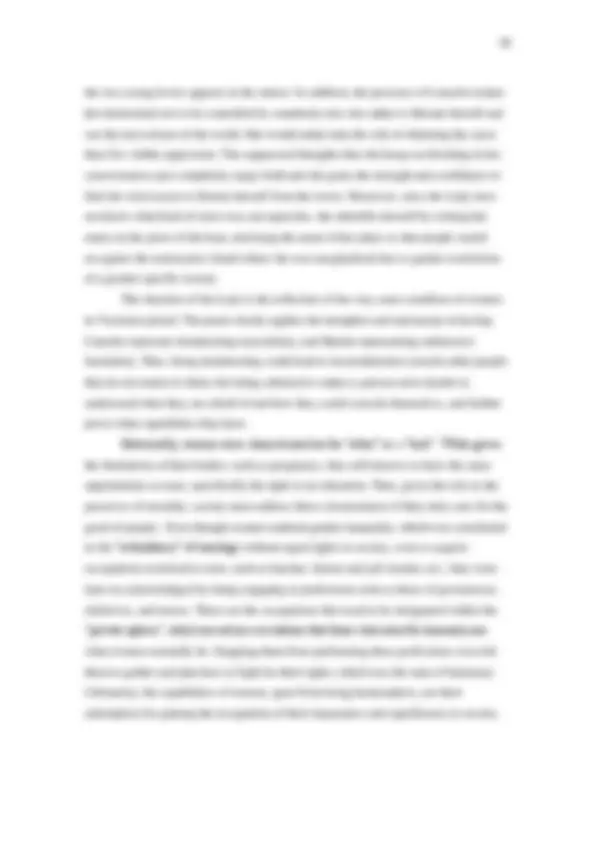
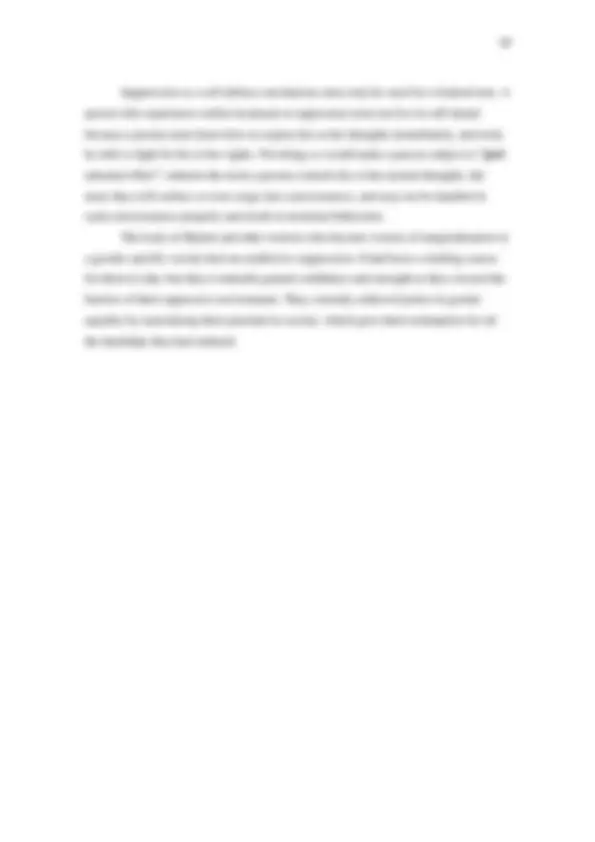
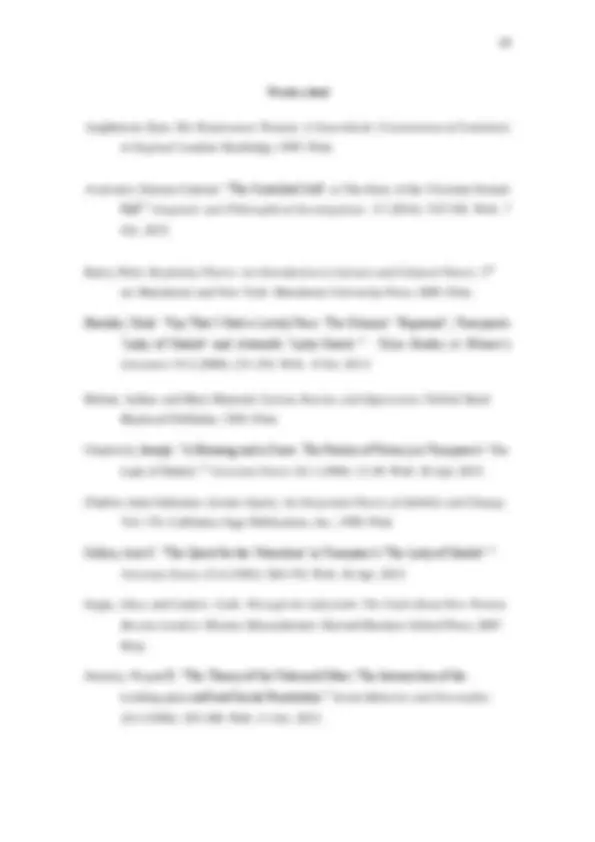
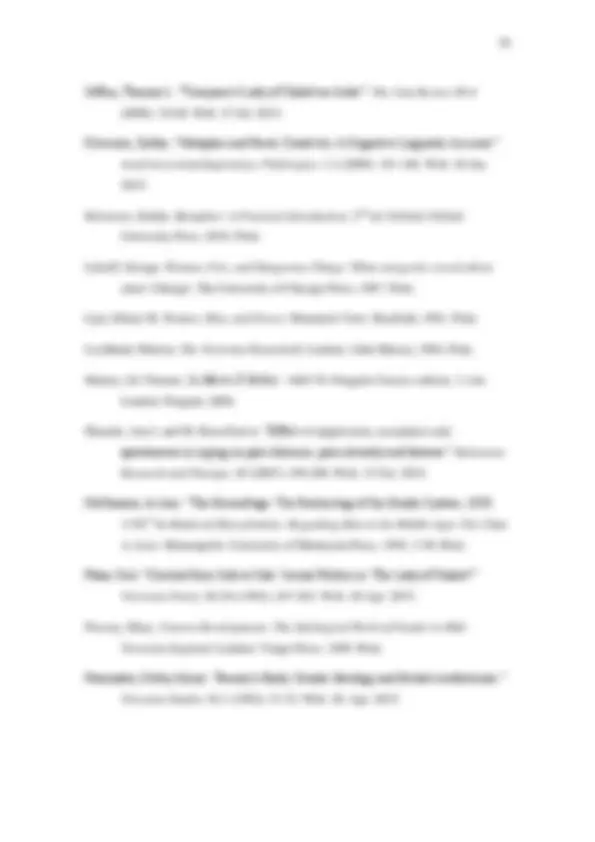
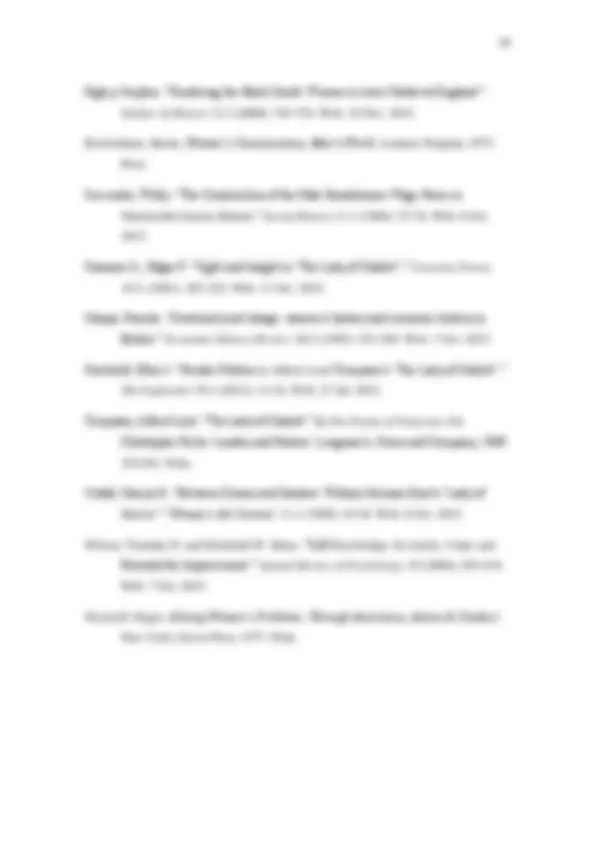


Study with the several resources on Docsity

Earn points by helping other students or get them with a premium plan


Prepare for your exams
Study with the several resources on Docsity

Earn points to download
Earn points by helping other students or get them with a premium plan
Community
Ask the community for help and clear up your study doubts
Discover the best universities in your country according to Docsity users
Free resources
Download our free guides on studying techniques, anxiety management strategies, and thesis advice from Docsity tutors
Likewise, the Lady of Shalott only achieves recognition from the public sphere of Camelot when she flees from her isolation amidst hardship and even in sorrow.
Typology: Lecture notes
1 / 24

This page cannot be seen from the preview
Don't miss anything!

















Abstract Alfred, Lord Tennyson’s poem “The Lady of Shallot” contains an enigmatic tale which can be interpreted as very relevant to society, most specifically for women who have been subordinated to patriarchy. The poem conveys in an elusive way the imbalanced gender ideology of Victorian Britain, using a metaphor entailing social and cultural contexts. Furthermore, it highly emphasizes the representations of both genders as either belonging to public and private spheres, or who are domineering and submissive, respectively. Like the Lady of Shalott, women were victims of social marginalisation, no matter how vital their roles were in a community. In his poem, Tennyson delineates gender roles and conditions from previous periods in British history, such as the Middle Ages, and the Renaissance and Victorian eras, in which women were considered less by society because of the limitation of their bodies. Likewise, it also presents their subjection as “redundancy”, in which a woman was bound only to marriage and to whatever her husband would provide. One of the activities that Victorian women were comfortable with was needlecraft, and this is Tennyson’s inspiration behind the Lady’s creativity in weaving. This also serves as their defence mechanism, or self-suppression, as to how they could control the thoughts of their oppressive circumstances, which are surfacing in their consciousness, by diverting their frustrations into something valuable while they build their aspirations on fulfilling their potential in society. Feminism has evolved because of women meeting to engage in needlework behind closed doors. The professions such as that of governess, nurse and midwife were entitled for women because these occupations are what they normally do in their private sphere. However, they were finally given recognition for these professions because they are truly essential to society. Likewise, the Lady of Shalott only achieves recognition from the public sphere of Camelot when she flees from her isolation amidst hardship and even in sorrow.
their dignity by obtaining professions that were highly fundamental to their community. Thus, prohibiting women to express their rights in society makes them more driven to fight for gender equality. Such a defence mechanism would be centred on how to endure and survive the propensity of an oppressive marginalisation in a gender specific society. Having the tendency to live in self-denial and not express ill-feelings for an unlimited time will not help a woman gain what she wanted in life. Hence, it is important to distinguish what makes a woman stop from doing so and to delineate how she will liberate herself from the barriers of marginalisation in order to attain liberation and redemption from the inequalities of gender ideologies. II. The Lady’s “survival” from marginalisation The Lady of Shalott finds refuge in her confinement within the tower by monotonously weaving a colourful web. The inspiration she perceives comes from the reflection that she sees in the mirror, which is obscure, given that she could not even see her own image but only the reflection of the “shadows of the world” (Tennyson l. 48 ). Consequently, no matter how fascinating the surroundings and the inhabitants of Shalott are, she could still never visualize the reality and truth behind the vagueness of the images. Hence, Sharyn Urdall mentions that the mirror symbolizes purity, truth, and fidelity (34), but the Lady has not yet discovered her identity at all. This prohibition is brought about by her marginalisation from the “public sphere”, where patriarchy dominates society. As a result, the Lady is only entitled to stay in the “private sphere” through her submissiveness. Even though the Lady knew that a curse would be cast upon her once she “looks down to Camelot” (l. 41), she tries to divert her attention to something that would make her productive and artistic. She, gradually, applies the defence mechanism of suppression to live normally and forget the transgression that she experiences. Through this, she frequently depends on the images that she sees in the mirror, and builds her individuality through them (Chadwick 18). The images consist of “troop of damsels glad” (l. 55), or “long-haired page in crimson clad” (l. 58), and others. Watching the shadowy images and turning them into a colourful web is an ironic circumstance since she could not make her situation as vibrant as the people from the “outside world” or
society in general; however, this is how she consoles herself in her seclusion. One concept which the Lady applies to her suppression is the theory of the “looking-glass self”. This theory was constructed by Charles Horton Cooley, and states that a person visualizes the appearance of himself or herself to another person (Hensley 94). It helps the Lady of Shallot to build her confidence by placing herself through those images, hoping that she, too, will have her own reflection or persona to look upon in the future. On the one hand, her weaving and imagination brings satisfaction to her life, but on the other, the vague images that appear and exit from the magic mirror only provide fragmented ideas, which are caused by a further curiosity and desire to see it clearly or experience them herself. Hence, the paradox of the magic mirror and her beautiful weaving makes her condition arduous because she would never attain any goal from staying by her loom, but will just be incessantly subject to isolation and be deprived of recognition of the other capabilities that she could provide in the outer world. Subsequently, the fourth stanza in the second part of the poem describes an unfathomable situation since funerals and weddings entail disconnected entities, in which the Lady is in “still delights/ To weave the mirror’s magic sights,/ For often thro’ the silent nights/ A funeral, with plumes and lights/ And music, went to Camelot:/ Or when the moon was overhead,/ Came two young loves lately wed” (ll. 64-70). She thinks that a funeral means the end of suffering and that makes her happy because ‘death’ would end a person’s misery. It just suggests that she is aware of her own misery, which she does not admit to. However, the successive characters who appear in the mirror are the couple who later got married; these are the only images she witnesses with intimacy signifying sharing one’s life with someone. That is the turning point of the Lady’s suppressed thoughts, in which she laments, “I am half sick of shadows” (l. 71). She eventually admits that she is tired of her condition of being alone, watching the vagueness of the world, and weaving repetitively what does not seem to end. The suppressed feelings and thoughts that she keeps gradually surface in her consciousness. She feels the burden of being incomplete and becoming subjected to “social castration”, an idea of Sandra Gilbert and Susan Gubar, which characterizes women’s inadequacy in terms of social power (Barry 125).
meekness, uncertainty, emptiness, whispers and speculations as to the Lady’s mysterious appearance, which serves a major role in her aim of crossing over from her private self, because she now becomes the one who catches the public’s gaze (Colley 273). Carl Plasa claims that the Lady’s journey towards Camelot through death conveys its own resistance to the transgression of gender divisions (250). It illustrates how difficult it is for women to define their identity, and when they do, there are constant obstructions in their way. The feminine subject in the tower and the feminine object in the boat are not the same woman since they have different worlds (Psomiades 36): the former used to live in comfort, “And little other care hath she” (l. 44) but suffers from self-denial, while the latter gradually builds up her confidence and strength and finds a substantial reason to face her battle for independence. The Lady’s determination to live fully and face death, if necessary, suggests that she will never base her identity upon other people again (Shannon Jr. 215) since she succeeds in gaining her personality and turning away from being an automaton (Shannon Jr. 216). III. The construction of the poem’s metaphor Poetry can be used as a context to characterize or signify what the poet would like to convey (Kövecses182). Zoltán Kövecses asserts that the major entities of poetic discourse are the speaker or poet, the topic, and the listener or recipient (185). In this manner, a conceptual metaphor is often applied in poetry which carries the details from its source domain to the target domain, or to the exact condition the poet would like to interpret (Lakoff 384). The source domain could be represented by concrete concepts such as plants, movement, body parts, journeys, etc., while a target domain could be understood by abstract concepts and is conveyed through social organization, life, theory, ideas, etc. The poet, Alfred Tennyson, indicates that marriage is the integral completion of women’s destinies (Plasa 252); therefore, the poem “The Lady of Shalott” features the target domain of the social structure of gender ideologies and women’s marginalisation in nineteenth-century England, and then its source domain through the Lady’s confinement in the tower. The very first lines “On either side the river lie/ Long fields of barley and of rye” (ll. 1-2) represent the source domain of place and cultivation, while the productive
locations of Camelot and Shalott represent the target domain. Hence, these places are also considered as metonymy or an entity that describes an environment physically and culturally (Kövecses 185). However, Tennyson highlights Camelot by stating “thro’ the field the road runs by” (l. 4), indicating that masculinity is the dominant and progressive gender; whereas, Shalott, as the “Gazing where the lilies blow/ Round an island there, below” (ll. 7-8), constitutes the private sphere of femininity. Though the island of Shalott is “round”, meaning a positive orientating metaphor (Lakoff 40), the spatial orientation of “below” represents a negative aspect where the female gender is considered as one that does not contribute as much as the male gender does in society. Kathy Alexis Psomiades characterizes the feminine representation of Shalott as being subjected to inferiority and submissiveness (34) since the Lady lives in the “Four grey walls, and four grey towers,” (l. 15) which is located on the far side of a “margin, willow-veil’d” (1.19). This explains that she is imprisoned in an excluded place or position in society, where her existence is completely cut-off from all social activity (Chadwick 17). Thus, the phrase “overlook a space of flowers” in line 16 denotes the failure of men to recognize or understand the status of women (Plasa 256), even though they are a productive gender as well. In general, the only activity in which the Lady engages is weaving. This is the equivalent of embroidering that kept a Victorian woman’s mind and fingers occupied while not pursuing her aspirations (Jeffers 58). The Lady is partly content with what she does, “There she weaves by night and day/ A magic web with colours gay” (ll. 37-38); this represents the repetitive activity that helped Victorian women to suppress their thoughts against the social exclusion of women in society. Moreover, one entity in the poem that signifies personification is the term, “moon” on line 69, “the moon was overhead”, in which a non-living thing is characterized in terms of human properties (Köveces 57). In addition, the moon is symbolically associated with menstruation, which is one of the aspects of Victorian’s femininity society tended to repress (Plasa 252). This indicates the start of the Lady’s frustration with her confinement. The description of Lancelot in lines 74- 77 , “He rode between the barley- sheaves/ The sun came dazzling thro’ the leaves/ Of bold Sir Lancelot” denotes how highly important a person he is. Being a character in Malory’s Le Morte D’Arthur, in which he portrayed one of the courageous knights of King Arthur and committed an
assessing her life by just being dependent on the comfort that is provided for her inside the tower, “And so she weaveth steadily,/ And little other care hath she” (ll. 41-42). The situation of the Lady parallels the disposition of women who accept their roles in domesticity since they are comfortable in their own “private sphere”. They have the tendency to rely on other people for their security and comfort without imparting any opinion on whether they are entitled to their rights or if they will be given credit for it or not, because they just accept the roles that society has given them, and, furthermore, find satisfaction in them. Thus, the implication is that men stereotype women as objects of desire and imprison them in a culturally constructed images (Plasa
the demands of parenthood and pass their tasks on to somebody else. This is similar in their manner of communication, which Robin Lackoff describes as “being polite with a specific voice tone and are prohibited the use of slang or curse words, which conveys the timidity and lack of conviction” (qtd. in Chafetz 68). Women who cross the barriers of the “public sphere” of industry encounter difficulties because they always have to watch their conduct and prove that they can surpass other’s expectations or criteria that have been imposed on them. For this reason, some women applied the notion of “penis envy”, which is a symbol of women’s social power (Barry 125) channelling their consciousness to be courageous, resourceful, creative, and fierce because men still perceive women as competitors in the workplace; and if they succeed, they will be considered as the “pathbreakers of social change” (Eagly 199). Women’s entry into previously male-dominated professions entails progression (Lips 2). The gender ideology has gradually become less traditional, and their tasks in household and career roles are starting to be equal. Due to this, women are no longer bound to only perform domestic roles and remain in their “private sphere”, but can also show their capabilities by achieving goals and expressing their rights against oppression through education and social inclusion. Peter Barry evaluates Freud’s Three Essays on the Theory of Sexuality as meaning “gender roles must be malleable and changeable, not inevitable and unchangeable givens” (125). Being restricted by gender division will just hinder a person from the tasks he or she wants to accomplish; therefore, it is necessary that a person must be adaptable to changes and respect others’ viewpoints to attain a harmonious society. V. The chronology of society’s gender roles A. Medieval period Men in the medieval period established themselves as highly notable persons. Their mere goal was to fight and there was no indication of passiveness in their personalities; therefore, they were always prepared to defend, or even show their harshness, by persecuting whoever would damage their image to prove their manhood. Women were their victims of exclusion and ruthless authority, along with homosexuals, heretics, and any rebel who did not belong to their social structures (McNamara 22).
could live comfortably while attending to her responsibilities as a homemaker (Aughterson 67). The woman’s passiveness and domesticity would complement the man’s industriousness as a farmer. As pertaining to duties of husband and wife, William Vaughan wrote The Golden Grove , informing his readers that one such duty is the husband’s compassion towards the wife, to not hurt her by word or deed, and he must also provide her needs and her housekeeping according to his ability. The wife, on the other hand, must not tell other people whatever flaws or inadequacies her husband has, else people would just make her a laughing stock or a villain, desperately trying to put down her other half (Aughterson 97). C. Victorian period The Victorian period was the most prosperous era among the previous ones since the industrial revolution in Britain was expanding. Because of this, there was a fresh bourgeois regime manifested in different households (Avarverei 543) and snobbery flourished within different classes of people (Lochhead 3). However, when it came to women’s condition, they were still subordinated to the archaic patriarchal supremacy. As Helene Moglen points out, men had an egoistic and aggressive nature over women’s self-denial and submissiveness (qtd. in Avarvarei 539), which was the very situation of the Lady of Shalott. Women, both in social and domestic life, from the middle class up to aristocrats, spent their time with needlecraft (Lochhead 6). Through this activity, Tennyson derives his inspiration for the poem that makes the Lady engage in weaving, like the Victorian women who kept themselves occupied with needlework in the pursuit of reproducing or rebuilding their own dreams, knowing they will be subjected to “redundancy”. The “redundant” lives of women in British history were alarming, since they were constricted to marriage, prostitution, or even spinsterhood (Urdall 35). They felt themselves in jeopardy because they could not get out of the monotonous task imposed on women, and they always had to stand next to their husbands. Moreover, some feminists stated that nineteenth-century fiction often implied that only few women looked for a job because they are often portrayed as bourgeois, and if they did, it is either because they ran away from their family or faced economic difficulties (Barry 117). However, the main concern was about who the woman has to marry, who is
nearly always a man suitable for her class, or even higher, and who would fulfil her needs. Stedman Jones stated that the household of a working-class family was not the best place for relaxation (qtd. in Seccombe 62). Men were usually exhausted from working long hours, and instead of going home after work, they would rather spend their time with their friends in the pub, using their wages for drinking rather than handing it over to their wives. Women, on the other hand, were very much devoted to their household, and just accepted whatever would be left from the husband’s income. Oftentimes, they were in debt and the wife would pawn whatever she could trade. A wife sacrificed a lot, even her own health, just to make sure that her family, most especially the breadwinner, was well-nourished. However, Louise Tilly and Joan Scott mention that there were also proletariat husbands who were sensible about their working conditions, or their general situations, who gave their salaries completely to their wives (qtd. in Seccombe 58). Being a good husband, in a working-class definition, is being one who does not neglect and hurt his family, or who does not abuse his salary and gives it to his wife (qtd. in Seccombe 62). The women’s working conditions in the Victorian period were dire because they were always being marginalised as being inadequate for jobs outside domesticity (Poovey 8), yet they were becoming resilient about this kind of condition. In the 1790’s, some women started to work in the market as butchers, or as wardens in jail. By the 1840’s, some women worked as dressmakers or milliners, since they had the skills to be stylists and catered to the elegance of the bourgeois classes. However, the most refined profession that was delegated for a woman was being a governess (Poovey 126): it is similar to being a mother, who taught children a basic education, conduct, and manners in a private household. Mary Poovey considers it the ideological work of gender because of the strong role it establishes, and thus she states, “the figure epitomized the domestic ideal, and the figure who threatened to destroy it” (127). It suggests that as a profession, it is considered as middle-class, a woman having a similar salary as men in the working-class. This became the start of the gradual equalization of the separateness of the private and public spheres. Being a governess was a status of concern to their contemporaries because of competition for employment. Men started to feel threatened about the capabilities of women and complained that it would destroy the morality of
defence system in which an idea is intercepted and blocked before it reaches the consciousness (qtd. in Dunn and Wilson 296), but if the anxiety aggressively provokes the person and reaches the consciousness, then suppression would be the next in line. Women like the Lady of Shalott, like women in the previous periods of British history, applied this kind of defence system to themselves because of the monotonous role that they had to play in society, for instance their engagement in needlework. They thought that in this way, they could primarily live normally by locking themselves in denial, and projecting that they were already indestructible and immune to the sense of pain (Wyckoff 35), rather than submitting themselves to anger and desolation. Historically and socially, women knew that they were being represented as vulnerable and defenceless, and had been kept out of the economic world and productive industry - and they kept on allowing themselves to be marginalised repetitively. Since suppression is associated with greater discomfort (Masedo and Esteve 200), pressure and anxiety would never be eradicated from their consciousness because they would like to be treated fairly. Daniel Wegner and his colleagues (qtd. in Masedo and Esteve 200) asked a set of participants to block or suppress their neutral thoughts and not express them; however, the suppressed thoughts just turned into frequent occurrences on their minds. Thus, it indicates that these thoughts could actually become more visible in one’s consciousness since the person is trying to hold them back and preventing him or herself from expressing them. Through this, the participants experienced the “post- suppression rebound effect”, which has a greater frequency of recalling the prohibited thoughts they had established in their minds (Wilson and Dunn 297). This is exactly what the Lady of Shalott experiences: the more she gets her inspiration for weaving from the shadowed images in the mirror, the more she cannot eradicate the oppression of her condition. Although she is aware of her imprisonment, it only strikes her severely when she sees the intimate image of the young lovers, the only time she gets tired and isolated, or feeling truly ostracised from society. However, in order to create a solution for women who face marginalisation in a gender specific environment, they must analyse what they lack and how strict their society is within the norms of gender ideologies. They have to figure out how to break it
and fight for their rights in order to prevent being subjected to any kind of oppression. Hogie Wyckoff mentions that there are three kinds of liberation contacts, which are the relationship with one’s self, the relationship with others, and the relationship with the world (47). In the Lady’s condition, she has no one to talk to and the only one who could help her to find liberation is herself. By the time she stops suppressing her feelings, she allows the sadness to surface in herself, which stimulates her to renew her opinion about the reality of her condition (Wyckoff 141) and accepts the fact that she can no longer cope with her oppressed situation. This also reflects how British women were subjected to marginalisation. They accepted their roles in society by being bound to their domestic lives and other types of occupations that still disregarded them in society, in which patience and tolerance were their intermediaries for suppression. Hence, through their relationship with other women who suffered the same treatment, and through education and experiences in their own “private sphere”, they became strong and sought for equality and eventually redeemed themselves by gaining recognition in professions that served as fundamental occupations in a community. Consequently, a woman who suppresses her thoughts in an oppressive environment must immediately analyse her weaknesses and capabilities. She must look for possibilities as to how she could establish herself to recognize her potentials, like the Lady of Shalott, who gained redemption by breaking the boundaries of marginalisation. VI. Summary and discussion The poem “The Lady of Shalott” addresses the topic of marginalisation in British society of the Victorian period, specifically on how women were being treated. Since the poem has a medieval theme, the society of Victorian Britain could easily relate to the character of Lancelot from Thomas Malory’s Le Morte D’Arthur , who fortifies his signification of men’s virility in his portrayal as one of the Knights of the Round Table, and through his illicit affair with the wife of King Arthur, Queen Guinevere. The situation corresponds to the Lady of Shalott’s reaction when she witnesses the two young lovers who later married, prior to the presence of Lancelot. It is the only time she admits how weary she is in her isolation. Such loneliness at being ostracised from the outer world and bearing her skills for her alone to see ,while trying to live normally,
The situation of women was still appalling, because they were worried if the wage of their husbands would be enough to put food on their plates. However, the Victorian era also marked the start of feminism. While middle-class women were embroidering, they also met different people who had radical opinions about the situation of society. The occupations, such as governesses, midwives, and nurses were the professions that have not been performed by men since these are all related to womanhood at that time. Men became uneasy about this because they felt threatened by having competition when it came to the labour force. This could just have been a result of arrogance and envy because they did not want women to be recognized in society apart from being homemakers; and what they were truly concerned about was their value as the dominant gender since the professions of women were truly essential to the community. Men could not be employed in those kind occupations, either, because they still entailed domesticity, but in a more refined and vital way. This is how women eventually redeemed themselves; their diligence, tolerance, resilience, and suppression had paid off. Succumbing to suppression indicates that a person is being oppressed. The defence mechanism of suppression is usually practiced by a person who likes to shield himself or herself from the injustices of his or her environment and who does not want to give way to anger. If a suppressed thought further enters the consciousness, the person must find a solution as to how he or she could resolve it, else, the person would experience a “post-suppression rebound effect” once it has not been acknowledged. It is important to recognize the person’s weaknesses and capabilities as to how he or she could resolve such issues. Historically and poetically, women who fought marginalisation acquired their redemption by not resorting to unthinkable decisions and actions. VII. Conclusion The Lady of Shalott used suppression as a defence mechanism while she is being confined in the tower. Although she is primarily not concerned with her oppressive way of living, which is caused by the colourful creation that she produces in her loom, seeing only dull images from her mirror makes her imprisonment uncomfortable. Thus, the only time she fully acknowledges her oppression and isolation is when the image of
the two young lovers appears in the mirror. In addition, the presence of Lancelot makes her determined not to be controlled by somebody else, but rather to liberate herself and see the real colours of the world. She would rather take the risk of obtaining the curse than live within oppression. The suppressed thoughts that she keeps on blocking in her consciousness just completely surge forth and she gains the strength and confidence to find the vital reason to liberate herself from the tower. Moreover, since the Lady does not know what kind of curse was cast upon her, she identifies herself by writing her name on the prow of the boat, enclosing the name of her place so that people would recognize the metonymic island where she was marginalised due to gender restrictions of a gender specific society. The situation of the Lady is the reflection of the very same condition of women in Victorian period. The poem clearly applies the metaphor and metonymy in having Camelot represent domineering masculinity, and Shalott representing submissive femininity. Thus, being domineering could lead to inconsideration towards other people that do not matter to them, but being submissive makes a person strive harder to understand what they are afraid of and how they could console themselves, and further prove what capabilities they have. Historically, women were characterized as the “other” or a “lack”. While given the limitations of their bodies, such as pregnancy, they still deserve to have the same opportunities as men, specifically the right to an education. Thus, given the role as the preserver of morality, society must address these circumstances if they truly care for the good of people. Even though women endured gender inequality, which was constituted in the “redundancy” of marriage without equal rights in society, even to acquire occupations restricted to men, such as butcher, farmer and jail warden, etc.; they were later on acknowledged by being engaging in professions such as those of governesses, midwives, and nurses. These are the occupations that used to be designated within the “private sphere”, which served as a revelation that these vital roles for humanity are what women normally do. Stopping them from performing these professions even led them to gather and plan how to fight for their rights, which was the start of feminism. Ultimately, the capabilities of women, apart from being homemakers, are their redemption for gaining the recognition of their importance and significance in society.